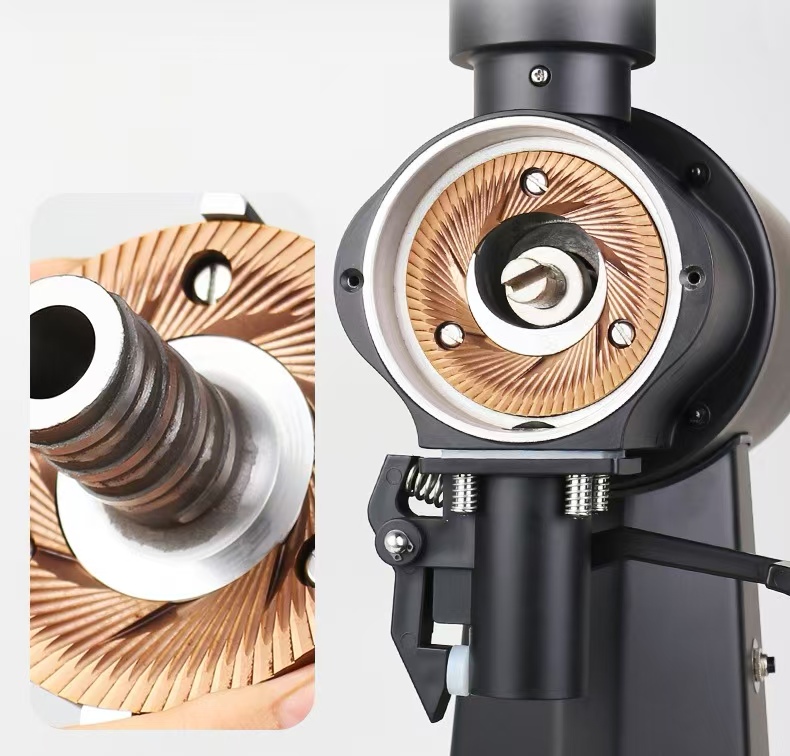When using a coffee grinder in a humid environment, it is essential to be vigilant against risks such as moisture damage to the equipment, electrical short circuits, coffee bean clumping, and abnormal extraction. The following are specific safety precautions and countermeasures:
First, core security risks and preventive measures
The risk of equipment moisture and electrical short circuit
Risk: A humid environment can easily lead to a decrease in the insulation resistance of the motor, increasing the risk of leakage. Moisture in the circuit board may cause a short circuit.
Measures:
After daily use, wipe the bean compartment and the flour outlet with a dry towel to avoid water residue.
When storing, place the grinding machine in a dry and well-ventilated area, away from water sources and damp walls.
Regularly check if the power cord and plug are dry and avoid operating in a humid environment.
The coffee beans are damp and the grinding is abnormal
Risk: Coffee beans are prone to clumping when exposed to moisture, which can lead to clogging of the grinder, uneven grinding, and affect the extraction effect.
Measures:
After opening the coffee beans, they should be sealed in a sealed can or with a sealed clip to avoid contact with air.
The coffee beans in the bean barn are recommended to be used up on the same day to avoid long-term storage.
If there are any remaining coffee beans in the bean storage, they can be placed in moisture-proof bags (such as silica gel desiccants) to absorb moisture.
Static electricity and dust explosion risks
Risk: A humid environment may reduce the accumulation of static electricity, but coffee dust may still generate sparks due to grinding and friction, causing a dust explosion.
Measures:
Keep the grinding area well-ventilated and install a dust concentration detector to ensure that the concentration is ≤5mg/m³.
Operators should wear anti-static wristbands to avoid static sparks.
Second, operation norms and emergency response
Operating Specifications
Add coffee beans in moderation: Avoid having too many coffee beans in the bean barn to reduce the probability of moisture.
Regularly clean up residues: After each use, clean up the residues on the grinding disc and the powder discharge channel to prevent clumping and blockage.
Avoid the entry of metal foreign objects: Before grinding, check if there are any metal debris mixed in the coffee beans to prevent short circuits or blade damage.
Emergency response
Leakage or short circuit: Immediately cut off the power supply, contact a professional for inspection and repair, and do not disassemble the machine by yourself.
Coffee bean lumps: Turn off the power, clean the coffee grinder with a soft brush, and avoid scraping the blades with hard objects.
If water enters the equipment: Immediately cut off the power, use a dry cloth to absorb the moisture, let it air dry naturally, then power on for testing. If necessary, send it for repair.
Third, maintenance and care suggestions
Daily cleaning
Cleaning frequency: It is recommended to clean at least once a week. In damp environments, it can be increased to once every three days.
Cleaning method:
Wipe the blade and the body with a soft cloth. Avoid direct rinsing with water.
When cleaning the bean barn, use a vacuum cleaner or soft brush to remove the residue and prevent water from entering.
Regular inspection
Electrical inspection: Check the power cord, plug and grounding wire every month to ensure they are in good condition and free from damage or aging.
Mechanical inspection: Check the wear of the blade every quarter. If the thickness of the cutting edge is greater than 0.3mm, it needs to be replaced in time.
Moisture-proof measures
Storage environment: Place a dehumidifier or a small dehumidifier at the storage area of the grinding machine to maintain a humidity of no more than 60%RH.
Packaging protection: When not in use for a long time, wrap the equipment with dust-proof film or store it in the original packaging box.
Fourth, response to special scenarios
The rainy season or continuous overcast and rainy weather
Suggestion: Power on and run the machine for 5 to 10 minutes every day to utilize the heat generated by the body to prevent moisture.
Operation: If the grinding machine has not been used for a long time, it needs to be thoroughly cleaned and run idle for a test before being reactivated.
High-humidity commercial environments (such as cafes)
Suggestion:
Install dehumidification equipment and control the humidity in the operation area at 40%-60%RH.
Use bean warehouses with better sealing to reduce the contact of coffee beans with moist air.


